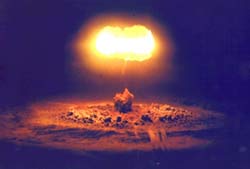What Is a Nuclear Meltdown?

A partial meltdown of nuclear fuel rods has occurred in two, or perhaps three, nuclear reactors at the Fukushima Daiichi power plant in Japan. What does that mean exactly?
"A meltdown is when the uranium dioxide fuel melts. The melting temperature of uranium dioxide is 5,189 degrees Fahrenheit (2,865 degrees Celsius)," said Martin Bertadono, a nuclear engineer at Purdue University.
Under normal circumstances, the uranium dioxide fuel rods are maintained at a temperature below their melting point. Heat emitted by the rods gets carried away by the water that surrounds it, which is constantly being pumped through the nuclear core housing the rods. But if the water doesn't get pumped through quickly enough, it heats up too much and starts boiling and evaporates. [Infographic: What Is a Nuclear Meltdown?]
"As the water boils, the level of water in the reactor decreases. If the level decreases below the top of the fuel, [the fuel] starts heating up. If this goes on long enough, about an hour, the uranium begins to melt," Bertadono told LiveScience.
"If the water is allowed to boil off completely the whole reactor could melt down," he said.
By flooding the failed nuclear reactors with seawater, technicians at the Fukushima plant seem to be averting a full meltdown, but a partial meltdown has already occurred.
What happens when there's a partial meltdown? "When the fuel melts, the [nuclear] fission products can be released from the fuel into the reactor pressure vessel, and then into the containment if the coolant leaks from the reactor vessel," said Taiwo Temipote, a nuclear scientist at Argonne National Laboratory. The containment is designed to hold in the radioactive material. [Infographic: Inside Japan's Nuclear Reactors]
Sign up for the Live Science daily newsletter now
Get the world’s most fascinating discoveries delivered straight to your inbox.









